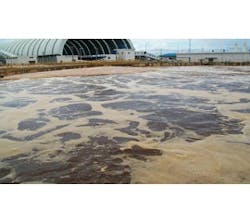About the author: Shawn Whitmer, P.E., is director of engineering for Probiotic Solutions. Whitmer can be reached at [email protected] or 480.423.6806.
Every facility is looking to lower operational costs while maintaining wastewater treatment efficiencies. One cost-saving measure is to reduce the quantity of chemicals that are used on a daily basis within a facility. Phosphorous is a key chemical ingredient for the pulp and paper industry that is used in the wastewater treatment process at each factory. If the amount of chemical can be reduced while maintaining the desired treatment results, then savings will be achieved.
The existing wastewater treatment system at a pulp and paper plant in China used 600 kg per day of diammonium phosphate (DAP) to provide the needed phosphorus concentration to maintain a healthy microbial population to treat wastewater. The microorganisms are essential in the treatment process, which is designed to break down the organic matter in the wastewater being discharged from the paper processing facility. Without the correct concentration of available phosphorus, the microorganisms are unable to grow and reproduce. If the microorganism population decreases, then the treatment plant’s effectiveness and efficiency are greatly reduced.
The plant was maintaining an effluent chemical oxygen demand (COD) concentration of 200 mg/L. The operators at the facility were not willing to negatively impact these results; therefore, much care and diligence were taken throughout the initial trial of the new product at the plant to ensure that it did not impact the effluent COD concentrations.
Treatment Solution
After thoroughly reviewing the information provided, the facility manager agreed to use Super Phos from Probiotic Solutions to replace DAP fertilizer as the phosphorous source. The daily dose was set at 75 kg, compared with 600 kg per day of DAP to treat the same volume of wastewater and provide the needed phosphorus for the microorganisms. This equates to an 87.5% reduction in volume of product. This large reduction in chemicals “reduced the storage space required, as well as labor costs in moving and dosing the product,” the plant manager said. In addition, by using the phosphorous product, chemical costs were reduced by more than 17%. The plant’s wastewater treatment efficiency was maintained even with the significant reduction in phosphorous used in the wastewater treatment facility. The effluent COD concentration was not negatively impacted by using the new phosphorous product, and it was maintained at 200 mg/L. Furthermore, after the addition of the new product, a microscopic analysis of the waste-activated sludge showed the microbiology from the treatment plant to be more active, and regrowth was much more vigorous than prior to using Super Phos.
Additional Benefits
By replacing DAP with the new phosphorous product, the facility also reduced the labor hours needed to handle the chemical, as well as the necessary storage facilities, which freed up valuable storage space for the facility. In addition, the facility’s treatment efficiency was maintained due to the improved microbiology in the wastewater. By reducing the amount of phosphorus being added to the system, corrosion has been reduced throughout the plant, as have deposits in the pipeline—further reducing long-term operational and maintenance costs.
The use of phosphorous products has proven itself in wastewater treatment applications where maximum performance is required and minimum effluent phosphorous concentrations are demanded.
Download: Here
